Clifford Simak Doubts His Religion
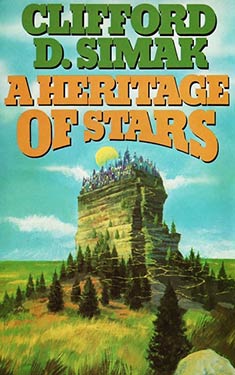 Clifford D. Simak became the third SFWA Grand Master in 1977, but few contemporary SF fans know his work today. A Heritage of Stars is one of his later books, one so obscure that Wikipedia doesn’t even have an entry for this 1977 novel. Simak was born in 1904, and died in 1988, so A Heritage of Stars was written in his mid-seventies, towards the end of his career. I think that’s significant because the book feels like a summation of Simak’s thoughts on science fiction. I know the older I get, the more I want to make sense of a lifetime of reading science fiction.
Clifford D. Simak became the third SFWA Grand Master in 1977, but few contemporary SF fans know his work today. A Heritage of Stars is one of his later books, one so obscure that Wikipedia doesn’t even have an entry for this 1977 novel. Simak was born in 1904, and died in 1988, so A Heritage of Stars was written in his mid-seventies, towards the end of his career. I think that’s significant because the book feels like a summation of Simak’s thoughts on science fiction. I know the older I get, the more I want to make sense of a lifetime of reading science fiction.
We’ve been reading A Heritage of Stars in my book club this month, and the consensus was it’s ho-hum. However, this is my second reading, and the story has improved — significantly. Simak cranked out sixteen novels in the last two decades of his life. Most of them have no entries on Wikipedia. Simak is famous for City (1952) and Way Station (1963), with his first story published in a 1931 issue of Wonder Stories. He wrote science fiction for six decades!
When you consider Simak’s unique perspective, A Heritage of Stars, takes on new meaning. It’s still just an average SF novel cranked out by a prolific writer, but I think it has something insightful to say about the genre we all love. I met Simak at a convention around this time, and I was shocked by how this Grand Master was ignored by young fans. Star Wars had just come out, and new fans were streaming into fandom. At the con they flocked to guests from media related science fiction, not old writers. Simak even looked from the past.
Writers of Simak’s era wrote science fiction as a gospel preaching promises of wondrous futures. Today, science fiction has become something different. Stories are often like fantasy, good storytelling and entertainment, with a bit of pop culture wisdom. Modern science fiction appears to inhabit the dreams of science fiction past. Something happened to science fiction when we stopped going to the Moon in 1972, and then spent over forty years just circling the Earth. NASA in the 1960s, with Projects Mercury, Gemini, and Apollo felt like it had grown out of 1950s Astounding Stories. Reading science fiction in the 1960s convinced fans we’d get to Mars in the 1970s, and the rest of the solar system by the 1990s. The 21st century would be beyond amazing. Here it’s 2016, and we’re still just jawboning about going to Mars. What happened?
Science fiction came of age with Simak in the 1950s, and peers like Heinlein, Asimov, Norton, Williamson, and Clarke. 1950s science fiction asked a lot of questions and generated its own theology. Science fiction’s true believers knew humans would go to the stars, build intelligent robots and evolve psychic powers. That’s the heaven 1950s science fiction promised, the collapse of civilization was its hell and brimstone.
A Heritage of Stars is Simak’s reevaluation of that theology. This is not a book review, so I’m going to give spoilers. If you don’t want to know them, read no further.
One thing that came through loud and clear in this novel is the legacy of L. Frank Baum and his Oz books. I read the fourteen canonical Oz books when I was a child in the early 1960s. Writers like Simak and Heinlein read them in the 1910s. Oz books became a tradition, published in time for Christmas. The original series ran from 1900-1920. Shelves of dissertations could be written on the impact of Oz books on science fiction writers. But there’s something else to note. Around the time the country was banning DC Comics, librarians decided not to carry Oz books because they claimed those books inspired unrealistic expectations in children. Couldn’t we say that about science fiction too?
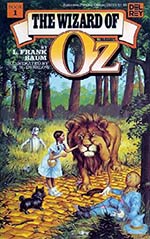 A Heritage of Stars is about a young man living a thousand years from now. Thomas Cushing, learning about a fabled “Place of Going to the Stars,” goes on a quest to find this site from our near future and his antiquity. Crossing a post-apocalyptic America, Cushing gathers a ragtag cohort of seekers. This is the basic plot of all the Oz books – a quest, a gathering of travelers, the meeting of amazing creatures and places along the way, and finally, a resolution of wonders. Of course, Cushing is Dorothy, and “Place of Going to the Stars” is the Emerald City, and there’s even a substitute for the Great and Powerful Oz, a robot called the A and R, for Ancient and Revered. Along the way, Cushing befriends a witch named Meg, a horse named Andy, a robot named Rollo, a man who communes with plants named Ezra, and his daughter who is a seer named Elayne. They meet strange people and fantastic creatures on their journey, just like all the characters in any Oz book.
A Heritage of Stars is about a young man living a thousand years from now. Thomas Cushing, learning about a fabled “Place of Going to the Stars,” goes on a quest to find this site from our near future and his antiquity. Crossing a post-apocalyptic America, Cushing gathers a ragtag cohort of seekers. This is the basic plot of all the Oz books – a quest, a gathering of travelers, the meeting of amazing creatures and places along the way, and finally, a resolution of wonders. Of course, Cushing is Dorothy, and “Place of Going to the Stars” is the Emerald City, and there’s even a substitute for the Great and Powerful Oz, a robot called the A and R, for Ancient and Revered. Along the way, Cushing befriends a witch named Meg, a horse named Andy, a robot named Rollo, a man who communes with plants named Ezra, and his daughter who is a seer named Elayne. They meet strange people and fantastic creatures on their journey, just like all the characters in any Oz book.
Towards the end of the novel, our travelers finally get an audience with the A and R, and many of the mysteries are explained. That is, the past is explained. The story doesn’t end with explanations, the final chapters offer hope for humanity. I won’t give that away, but I am going to explain the mysteries that Cushing sought for so long. I believe what Cushing learns is what Simak thinks as the reality of science fiction. I’ll just let Simak explain for himself:
The A and R settled himself comfortably in the chair and looked at them for a long time before he spoke, as if he might be evaluating them, perhaps debating with himself the question of whether he might have made a mistake in inviting them to this conference.
Finally, he spoke. “I am pleased,” he said, “to welcome you to the Place of Going to the Stars.”
Cushing hit the table with his open hand. “Cut out the fairy tales,” he yelled. “This can’t be the Place of Going to the Stars. There are no launching pads. In a place like this the logistics would be impossible.”
“Mr. Cushing,” the A and R said gently, “if you’ll allow me to explain. No launching pads, you say. Of course there are no launching pads. Have you ever tried to calculate the problems of going to the stars? How far they are, the time that it would take to reach them, the shortness of a human life?”
“I’ve read the literature,” said Cushing. “The library at the university—”
“You read the speculations,” said the A and R. “You read what was written about going to the stars centuries before there was any possibility of going to the stars. Written when men had reached no farther into space than the moon and Mars.”
“That is right, but—”
“You read about cryogenics: freezing the passengers and then reviving them. You read the controversies about faster-than-light. You read the hopefulness of human colonies planted on the earthlike planets of other solar systems.”
“Some of it might have worked,” said Cushing stubbornly. “Men, in time, would have found better ways to do it.”
“They did,” said the A and R. “Some men did go to some of the nearby stars. They found many things that were interesting. They brought back the seeds from which sprouted the belt of Trees that rings in this butte. They brought back the living rocks, the Shivering Snakes and the Followers, all of which you’ve seen. But it was impractical. It was too costly and the time factor was too great. You speak of logistics, and the logistics of sending human beings to the stars were wrong. Once you get into a technological system, once it’s actually in operation, you find what’s wrong with it. Your perspectives change and your goals tend to shift about. You ask yourself what you really want, what you’re trying to accomplish, what values can be found in the effort you are making. We asked this of ourselves once we started going to the stars and the conclusion was that the actual landing on another planet of another solar system was, in itself, of not too great a value. There was glory, of course, and satisfaction, and we learned some things of value, but the process was too slow; it took too long. If we could have sent out a thousand ships, each pointed toward a different point in space, the returns would have been speeded up. It would have taken as long, but with that many ships there would have been a steady feedback of results, after a wait of a few hundred years, as the ships began coming back, one by one. But we could not send out a thousand ships. The economy would not withstand that sort of strain. And once you had sent out a thousand ships, you’d have to keep on building them and sending them out to keep the pipeline full. We knew we did not have the resources to do anything like that and we knew we didn’t have the time, for some of our social scientists were warning us of the Collapse that finally overtook us. So we asked ourselves— we were forced to ask ourselves— what we were really looking for. And the answer seemed to be that we were seeking information.
“Without having lived through the era of which I talk, it is difficult to comprehend the pressures under which we found ourselves. It became, in time, not a simple matter of going to the stars; it was a matter of pulling together a body of knowledge that might give us a clue to actions that might head off the Collapse foreseen by our social scientists. The common populace was not fully aware of the dangers seen by the scientists and they were generally not aware at all of what we were doing. For years they had been bombarded by warnings from all sorts of experts, most of whom were wrong, and they were so fed up with informed opinions that they paid no attention to anything that was being said. For they had no way of knowing which of them were sound.
“But there was this small group of scientists and engineers— and by a small group I mean some thousands of them— who saw the danger clearly. There might have been a number of ways in which the Collapse could have been averted, but the one that seemed to have the best chance was to gamble that from the knowledge that might be collected from those other civilizations among the stars, an answer might be found. It might, we told ourselves, be a basic answer we simply had not thought of, an answer entirely human in its concept, or it might be a completely alien answer which we could adapt.”
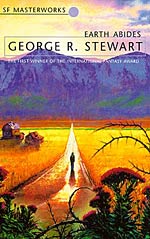
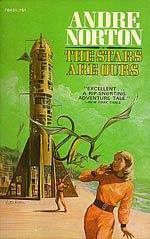 Get the reference to science fiction? Cushing had learned to read, and found science fiction novels, probably from our time. He didn’t know they were SF, and had built his dreams on them. Simak is telling us the future won’t be science fiction. One of the major themes of 1950s SF is the collapse of civilization. Stories like Earth Abides, The Stars are Ours!, The Long Tomorrow and A Canticle for Leibowitz imagined our civilization not making it. A Heritage of Stars is one of those tales.
Get the reference to science fiction? Cushing had learned to read, and found science fiction novels, probably from our time. He didn’t know they were SF, and had built his dreams on them. Simak is telling us the future won’t be science fiction. One of the major themes of 1950s SF is the collapse of civilization. Stories like Earth Abides, The Stars are Ours!, The Long Tomorrow and A Canticle for Leibowitz imagined our civilization not making it. A Heritage of Stars is one of those tales.
Science fiction writers all have pet ideas. Simak loved robots, and he also loved imagining intelligent beings that were extremely different from humans. He often wrote about plants with awareness. And like many Sci-Fi writers from the 1950s, he loved the idea of psychic powers. The novel goes on to explain the role of robotic probes and robots in the future.
“But you knew about the Place of Going to the Stars?”
“Not from the history. Wilson knew of it, but he did not put it in his history. He dismissed it, I suppose, because it seemed too wild a tale. I found some of his notes, and he made mention of it in them.”
“And you came hunting for it. But when you found it, you did not believe it could be the place you were looking for. No launching pads, you said. At one time there were launching pads, quite some distance from this place. Then, after a time, after we saw that it wouldn’t work, we asked ourselves if robotic probes would not work as well as men.…”
“The gossipers,” said Cushing. “That is what they are— robotic interstellar probes. The Team looks on them as story tellers.”
“The Team,” said the A and R, “are a pair of busybodies from some very distant planet who intend someday to write what might be called “The Decline and Fall of Technological Civilizations.’ They have been vastly puzzled here, and I’ve made no attempt to set them straight. As a matter of fact, I’ve made it my business to further puzzle them. If I gave them any help, they would hang around for another hundred years, and I don’t want that. I’ve had enough of them.
“The travelers— those probes you call the gossipers— could be made far more cheaply than starships. The research and development was costly, but once the design was perfected, with the various sensors all worked out, the information processing design— so that the probes could use their own data to work out information instead of just bringing back to us masses of raw data— once all this was done, they could be made much more cheaply than the ships. We built and programmed them by the hundreds and sent them out. In a century or so, they began coming back, each of them crammed with the information he’d collected and stored as code in his memory storage. There have been a few of them who have not come back. I suppose that accidents of various kinds might have happened to them. By the time the first of them started coming back, however, the Collapse had come about, and there were no humans left at this station. Myself and a few other robots, that was all. Now even the few other robots are gone. Through the years, there has been attrition: one of them killed in a rockfall; another falling victim to a strange disease— which puzzles me exceedingly, since such as we should be disease-immune. Another electrocuted in a moment of great carelessness, for despite the candle, we do have electricity. It is supplied by the solar panels that top this building. The candle is because we have run out of bulbs and there is no way to replace them. But, however that may be, in one way or another all the robots but myself became dysfunctional until only I was left.
“When the travelers came back, we transferred their coded data to the central storage facility in this place, reprogrammed them and sent them out again. In the course of the last few centuries I have not sent them out again as they came back. There has seemed little sense in doing so. Our storage banks are already crowded…
We have lived decades past the time when Simak wrote A Heritage of Stars, but I don’t think his observations have been proven wrong. We’re learning that space travel is well suited for machines. Even writers like Kim Stanley Robinson have begun to question the role of interstellar travel, read his novel Aurora. Most of us have long given up believing in psychic powers. Robots, now that’s another issue. We seem to be moving ahead at Warp 4 towards building them. On the other hand, we’re moving at Warp 9 towards destroying our civilization and planet.
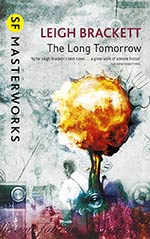
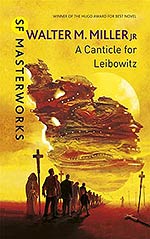 Simak has two robots from a distant stellar system visiting the Earth. They are writing a study on technological civilizations that have collapsed. These machine visitors want to know why such civilizations never recover. Cushing and friends want to prove them wrong, and the rest of A Heritage of Stars are about those plans.
Simak has two robots from a distant stellar system visiting the Earth. They are writing a study on technological civilizations that have collapsed. These machine visitors want to know why such civilizations never recover. Cushing and friends want to prove them wrong, and the rest of A Heritage of Stars are about those plans.
We face many storm clouds in our future. Our economy is not built on sustainability. If our technological civilization collapsed, would it ever recover? Will it survive long enough to create intelligent machines, our possible successors? It appears that Simak thought the central tenet of the science fiction religion, that humanity will travel to the stars, might be no more real than heaven was for earlier religions. Our species was designed for Earth, and if we destroy it, we have no place to go. Robots can leave, but not us. Simak was still a true believer in the wonders of what we might find orbiting distant stars, but he had become an atheist to the idea of humans spreading across the galaxy.
Are his doubts, my doubts, and Kim Stanley Robinson’s doubts, because we’re getting older?
I don’t think A Heritage of Stars is a major novel, but it is one I’ve grown to admire. As I get even older, I will return to it. I grew up reading Robert A. Heinlein, but in 1960 he took a left turn into the Twilight Zone. Asimov and Clarke kept returning to their old works to rehash old ideas. Old science fiction writers are interesting, because as they age, they must face reality. Reality is hard on all theologies.
 My all-time favorite science fiction novella is “The Star Pit” by Samuel R. Delany. It’s a story about characters of different ages coming to grips with different barriers. At 13, in 1964, I read Have Space Suit-Will Travel, that converted me to the religion of science fiction. But at 16, I discovered my skepticism with “The Star Pit.”
My all-time favorite science fiction novella is “The Star Pit” by Samuel R. Delany. It’s a story about characters of different ages coming to grips with different barriers. At 13, in 1964, I read Have Space Suit-Will Travel, that converted me to the religion of science fiction. But at 16, I discovered my skepticism with “The Star Pit.”
Evidently, we can never travel as far as we dream. Young science fiction fans will hate that pessimism. They want Star Trek and Star Wars to come true, like the followers of ancient religions want what they were promised.
I believe A Heritage of Stars is a moment of doubt for Simak. The last chapters represent either hope he found during a dark night exploring his aging soul, or Simak writing what he knew his young readers wanted. Or maybe what they needed.



















 Full Details
Full Details
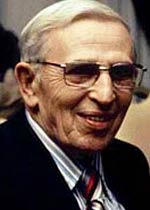


4 Comments
Great post! I am a Simak fan from way back; I liked his novels and his short stories – but I never heard of this one. I am going to have to find it….
Then I have great news for you Ed, many of Simak’s lesser known titles are back in print as ebooks and audio books. Plus, his collected short stories were recently published in a multi-volume ebook edition. I hope this is a sign that Simak will be rediscovered by new readers.
I love listening to these books.
An excellent essay about (I believe) an insightful book.
Great writing, thank you!
Sorry, the comment form is closed at this time.